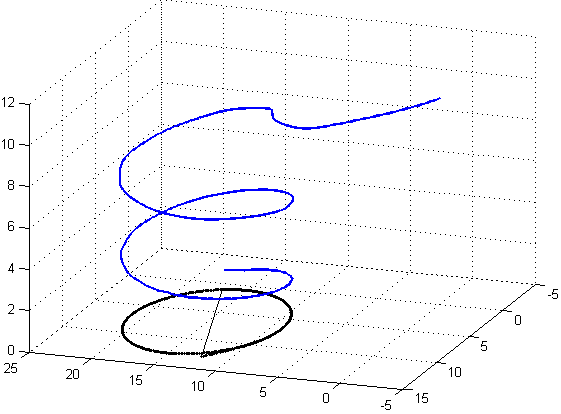Jan 21, 2013 , by Miguel Angel Olivares Mendez
Public Summary Month 1/2013
After the developed of an optimized controller for see and avoid task, the CVG-UPM was working on control all the degrees of freedom of the unmanned aerial vehicle to develop an autolanding control system. First this autolanding control system must be applied to land in static platform. Simulated experiments were done with successful results. Despite the control system was trained to land on a static landmark, the experiments shows that the aircraft can land on moving platform. The next Figure shows one of the simulated experiments, in which the blue line represents the aircraft movement and the black line the landmark movement.

APIA XXI was centered in providing further details and parameters for the end demonstration case conditions, including video and images used to prepare de algorithms and evaluate the capability of the framework adaptation.
Next Figure show the land met mast prototype designed by APIA XXI. On the top of this mast are installed different sensors to check the environment conditions.

Nov 14, 2012 , by Miguel Angel Olivares Mendez
Public Summary Months 08-09/2012
The aerial vehicle was tested with excellent result in the headquarters of Skybotix. Now is time to select the specific sensors for the inspection, avoid collisions and auto-landing tasks of the OMNIWORKS Experiment. The land prototypes of the met mast are also ready to be used, after a big amount of test to simulate the wave movement of the off-shore met mast. A set of videos was record to UPM-CVG can adapt the visual algorithms to detect and inspect the different sensors mounted on these met mast. The optimization algorithm and the simulation to find the optimal controller to command the aircraft is ready to use. Some test of see and avoid were done to check the behavior of the optimization process.
Aug 24, 2012 , by Miguel Angel Olivares Mendez
Public Summary Month 8/2012
An unmanned aerial vehicle has a high number of electronics onboard. The selection of all the components is a hard task because the playload is limited. We need to select the more efficient and light of each desirable component. Six motors were installed on the aircraft to increase the playload. A latest model laser sensor was installed onboard. Now is time to decide the type of the camera and the computer to put onboard. This CPU will use the camera and laser acquired information to commands the aircraft to inspect the met pole and to avoid possible collisions.
Jun 10, 2012 , by
Public Summary Month 5/2012
The number of offshore windmills is increasing across the oceans and seas, for whose appropriate localization companies need to measure the environmental conditions at different spots over the see. The met masts developed by APIAXXI are the perfect structures to get this information, but also these structures need to be inspected and maintained. During the last two months a sophisticated autonomous flying prototype was design by Skybotix. On board this advanced aircraft will be working novel approaches of autonomous avoiding collision algorithms and visual inspection systems developed by CVG-UPM. The masts of more than 90 meters move without control under the chaotic commands of waves and wind in the Cantabrian Sea. To create a met mast inspection demonstrator a group of experts from APIAXXI were measuring the environmental conditions and the movements of these large structures.
Apr 17, 2012 , by
Public Summary Month 3/2012
The aim of OMNIKWORKS is to exploit the growing interest and convenience of using small scale UAV by developing a series of self enclosed specialized and complementary modules and applications suitable for a large variety of commercial UAV currently on the market. This modular scheme will allow a generic UAV to be easily adjusted for different kind of inspection operations, considerably reducing the equipment, system and inspection costs. In the specific case of this experiment a co-worker system will be developed to inspect the instrumentation of large floating offshore met mast buoys of 90 meters high.








